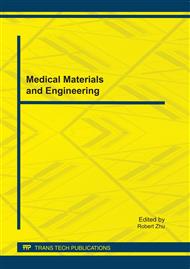[1]
G. Yohannes, K.H. Pystynen M.L. Riekkola, et al. Stability of phospholipid vesicles studied by asymmetrical flow field-flow fractionation and capillary electrophoresis, Analytica Chimica Acta. 560 (2006) 50-56.
DOI: 10.1016/j.aca.2005.12.042
Google Scholar
[2]
Y.H. Liu, L Hu,W.B. Wang, et al, Theoretical analysis of the experimental results of interaction of the atomic force microscopy with the lipid bilayers, Science and technology review. 28(2010)48-51.
Google Scholar
[3]
G. Hui, Y. Zhao, W. Zhang, et al, Raman spectroscopy study on the interaction of Ginsenoside Rb1 with DPPC bilayers, Spectroscopy and Spectral Analysis. 30(2010)2393-2396.
Google Scholar
[4]
X. M Li, B. Zhao, D.Q. Zhao, et al, Interaction of La3+ and cholesterol with dipalmitoylphosphatidylglycerol bilayers by FT-Raman spectroscopy, Thin Solid Films. 284-285 (1996) 762-764.
DOI: 10.1016/s0040-6090(95)08440-1
Google Scholar
[5]
M. KShih M.L. Hu, Relative roles of metal ions and singlet oxygen in UVA-induced liposomal lipid peroxidation, Journal of Inorganic Biochemistry. 77 (1999)225–230.
DOI: 10.1016/s0162-0134(99)00205-6
Google Scholar
[6]
N. Wang, W Wang X.R. Zhu, et al, UV-Radiation induced oxidative damage modification by cholesterol in phosphatidylcholine and liposomal membrane,J. Radiat. Res. Radiat. Process. 25(2007)115-118.
Google Scholar
[7]
W.W. Sulkowski,D. Pentak,K. Nowak, et al. The influence of temperature, cholesterol content and pH on liposome stability, Journal of Molecular Structure. 744-747 (2005)737-747.
DOI: 10.1016/j.molstruc.2004.11.075
Google Scholar
[8]
G.R. Zu,F.D. Kong,Y. Liu, Inactivation effects of high power pulsed field on the microorganisms, High Voltage Engineering. 30(2004)47-49.
Google Scholar
[9]
H.W. Ding C.L. Wang, Effect of high intensity pulsed electric fields(PEF) on microbes and enzyme activity in milk, Journal of Henan University of Technology(Natural Science Edition). 29(2008)46-49.
Google Scholar
[10]
Y. Zhou,Z. Chen Y.J. Yang, Application of pulsed electric fields on the sterilization of liquid whole egg, Food Science. 28(2007)60-64.
Google Scholar
[11]
Y. Wu,G.S. Mittal M.W. Griffiths, Effect of pulsed electric field on the inactivation of microorganisms in grape juices with and without antimicrobials, Biosystems Engineering. 90(2005) 1-7.
DOI: 10.1016/j.biosystemseng.2004.07.012
Google Scholar
[12]
G.A. Evrendilek,Z. Tjin, K.T. Ruhlman, et al, Microbial safety and shelf-life of apple juice and cider processed by bench and pilot scale PEF systems, Innovative Food Science and Emerging Technolgies. 1(2000)77-88.
DOI: 10.1016/s1466-8564(99)00004-1
Google Scholar
[13]
U. Zímmermann, Electric breakdown electropermeabilization and electrofusion, Rev Physisol Biochem Phamacol. 105(1986) 176-256.
Google Scholar
[14]
V.M. Humberto,U. R Pothakamury F.J. Chang, et al. Inactivation of E. coli by combining pH, ionic strength and pulsed electric fields hurdles, Food Res Int. 29 (1996)117-121.
DOI: 10.1016/0963-9969(96)00015-4
Google Scholar
[15]
Zhong Han, Xin-an ZengBen-shan Zhang, et al. Effect of pulsed electric fields(PEF) treatment on the properties of corn starch, Journal of Food Engineering, 93(2009)318-323.
DOI: 10.1016/j.jfoodeng.2009.01.040
Google Scholar
[16]
Y.M. Qu, Raman spectroscopy in application of structure biology, Chemical industry press, Bejing, 2005, pp.101-121.
Google Scholar
[17]
P.G. Bruce, L. P Warner, On the quantitative interpretation of biomembrane structure by Raman spectroscopy, Biochimica Et Biophysica Acta, 465(1997) 260-274.
DOI: 10.1016/0005-2736(77)90078-5
Google Scholar


